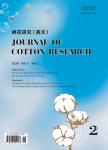Management of cotton bollworms Helicoverpa armigera and Earias vittella by ento mopathogenic nematodes
Management of cotton bollworms Helicoverpa armigera and Earias vittella by entomopathogenic nematodes作者机构:Department of NematologyTamil Nadu Agricultural UniversityCoimbatoreTamil Nadu 641003India
出 版 物:《Journal of Cotton Research》 (棉花研究(英文))
年 卷 期:2022年第5卷第2期
页 面:143-152页
学科分类:0710[理学-生物学] 0831[工学-生物医学工程(可授工学、理学、医学学位)] 1203[管理学-农林经济管理] 09[农学] 0903[农学-农业资源与环境] 0904[农学-植物保护] 090401[农学-植物病理学] 0836[工学-生物工程] 090402[农学-农业昆虫与害虫防治] 0713[理学-生态学]
基 金:the Life Science Research Board Defense Research and Development Organization New Delhi India for the financial support through a grant (No. DLS/81/48222/LSRB-136/FSB/2007)
主 题:Bollworms management Cotton EPN Foliar application Heterorhabditis bacteriophora Steinernema carpocapsae
摘 要:Background: The bollworm complex consisting of Helicoverpa armigera and Earias vittella is a major threat in cotton production globally. The habit of developing resistance to many insecticides including Bt transgenic cotton necessitates the exploration of an alternate strategy to manage bollworms. The entomopathogenic nematodes(EPN) Steinernema carpocapsae strain APKS2 and Heterorhabditis bacteriophora strains KKMH1 and TRYH1 at different concentrations of 1 × 10^(9) infective juveniles(IJs)·hm^(-2), 2 × 10^(9)***^(-2), and 3×10^(9)IJs·hm^(-2) in 500 L of water were evaluated as a foliar spray in fields naturally infested with *** and *** located at Eastern Block and and Cotton Research Farm of Tamil Nadu Agricultural University, Coimbaotre, India during October 2010–February 2011 and October 2011–February 2012, ***: In general, all three tested EPN strains reduced the larval population of H. armigera and E. vittella;reduced square and boll damage;and subsequently increased cotton yield compared with the untreated control. The S. carpocapsae APKS2 is most e ective against H. armigera whereas both S. carpocapsae APKS2 and H. bacteriophora KKMH1 were equally effective against E. vittella. The higher dose of 3×10^(9)IJs·hm^(-2) was highly significant in the reduction of H. armigera larvae. However, the doses 2×10^(9)IJs·hm^(-2)and 3×10^(9)IJs·hm^(-2) were equally effective for E. vittella control. The S. carpocapsae APKS2 at 3×10^(9)IJs·hm^(-2) caused a 62.2% reduction of H. armigera larvae, 34% reduction of square damage, 58.5% reduction of boll damage, and yielded 45.5% more seed cotton than the untreated control plots. In E. vittella infested field, S. carpocapsae strain APKS2 and H. bacteriophora strain KKMH1 at 2×10^(9)IJs·hm^(-2)resulted in 60.6%~62.4% larva reduction, 68.4%~70.7% square damage reduction, 66.6%~69.9% boll damage reduction and 45.9% yield increase over the untreated control. The effective EPN treatments were compa



